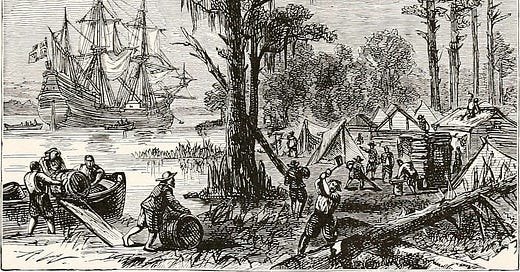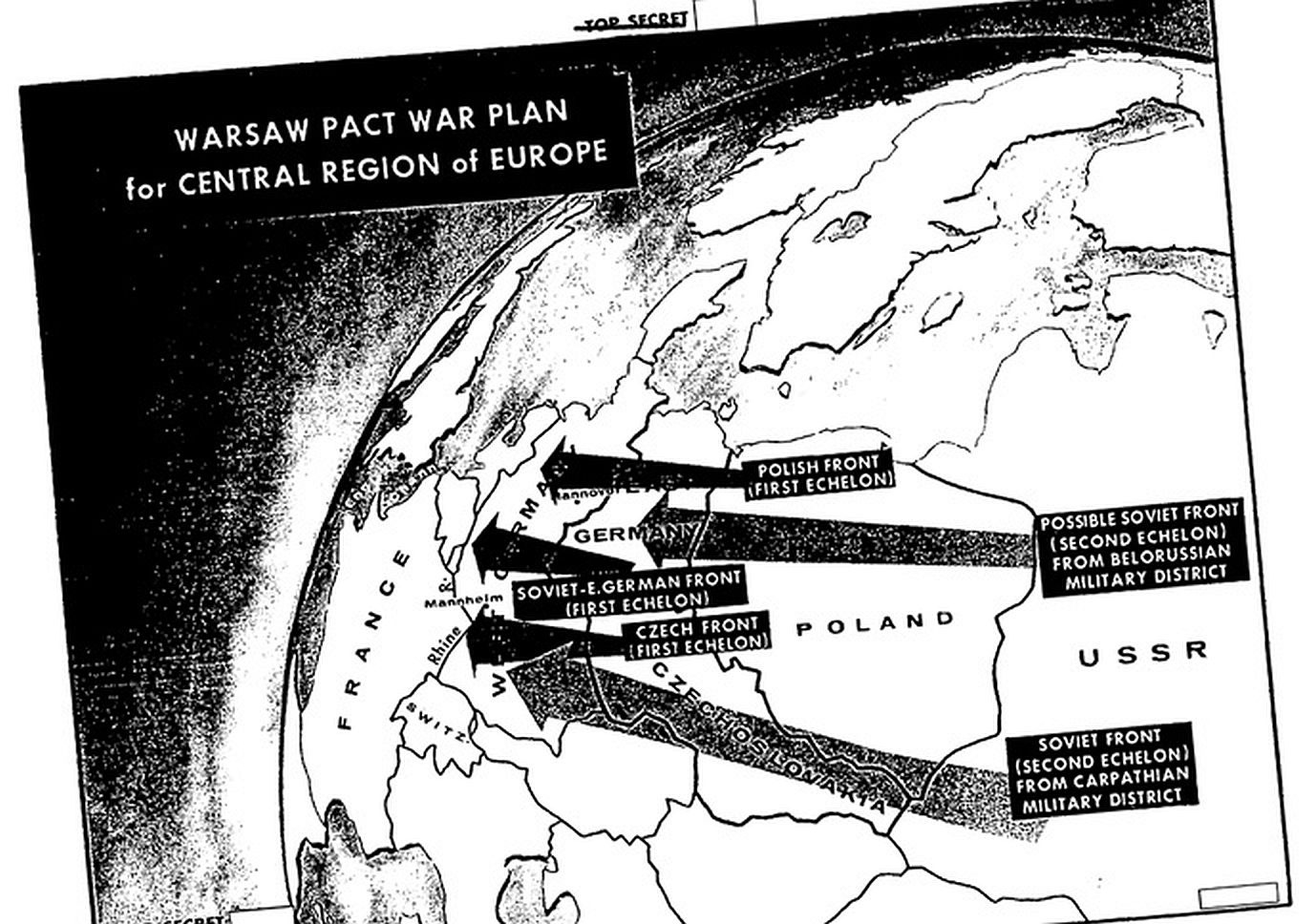The Mysteries of History (May 14 Edition)
Colonial Jamestown; Lewis & Clark; Israel; Warsaw Pact
1607 — England’s First North American Outpost Founded
public domain image from wikimedia commons
Thirteen years before the Mayflower arrived in Massachusetts, the first permanent settlement of Englanders was founded along the James River in Virginia. King James sent them, and their new town was christened Jamestown.
NOTE: What is called The Lost Colony of Roanoke would have been the first permanent English settlement, as they arrived in Roanoke (an island in what is now part of North Carolina) in 1587, but they quickly and suddenly disappeared without a trace. It is still a mystery what was meant by the word CROATOAN carved in a tree near the location of their camp. Even before that, there was a short-lived colony at the same spot who arrived in 1585 but were soon lost, killed, or assimilated by the natives.
Within two weeks of the 1607 arrival at Jamestown, the English adventurers were attacked by Native Americans, specifically the Algonquians. The initial onslaught was successively repulsed by the newcomers, but that wasn’t the end of their troubles. Not being prepared for the new conditions they had put themselves in, the Europeans had to contend with disease, starvation, and further aggression by the local inhabitants.
Although the beleaguered Britishers had planned to return to England after the brutal winter of 1609-1610, English reinforcements arrived and convinced them to remain. Tobacco was successfully planted, a cross-cultural marriage was effected between tobacco farmer John Rolfe and Chief Powhatan’s daughter Pocahontas, and as a result the English finally got a firm foothold in the new (to them) Land.
Later, following the death of Powhatan, conflict again arose between the Nouveau Americans and the Native Americans, but the steadily increasing numbers and power of the newcomers led to a subjugation of the original inhabitants.
Image generated by Google Gemini
Questions: What role did John Smith play in the relations between the English and the Algonquians. How did the marriage of John Rolfe and Pocahontas turn out? What do you think happened to “The Lost Colony of Roanoke”?
1804 — Lewis & Clark Expedition Begins
public domain images from wikimedia commons
Wanting to make sure he hadn’t bought a pig in a poke, President Thomas Jefferson sent a team led by Meriwether Lewis and William Clark to inspect the vast swath of territory the U.S. had purchased from France “sight unseen.”
It was on this date in 1804 that Lewis & Clark and about forty others left St. Louis, Missouri, on that mission. Along the way, they picked up French-Canadian fur trader Toussaint Charbonneau and his Native American wife Sacagawea, who served as interpreters when the group met French- or Shoshone-speaking residents of the area they traversed.
The “Corps of Discovery” returned to St. Louis two-and-a-half years later with knowledge, specimens, and experiences, as well as claims to the “Oregon Territory” in the Pacific Northwest.
The following is what I wrote about the Lewis & Clark Expedition in my book Still Casting Shadows: A Shared Mosaic of U.S. History — Volume 1: 1620-1913:
“Go West, young man, go West, and grow up with the land.”—John Soule
“The West is a place that has to be seen to be believed, and it may have to be believed in order to be seen.”—N. Scott Momaday
Even prior to purchasing vast tracts of land to the West, President Thomas Jefferson was curious about what wonders the West held. The Louisiana Purchase heightened this curiosity. Jefferson sent his protégé and personal secretary Meriwether Lewis, and William Clark, as co-captains on an expedition of about forty men to record data about the flora, fauna, and geography of the region. They were also to make peaceful contact with Indians they came across. Especially, though, they were to try to find a Northwest Passage, a route to the Pacific from the Mississippi River via waterways. But like the fabled El Dorado and the yearned-for Fountain of Youth, such a passage sim ply did not exist. As the song says, though, “two out of three ain’t bad.”
Early on in the voyage, the Corps of Discovery traversed the southern boundaries of what would in the future become Carroll and Chariton counties in northern Missouri. This is where Albert Lee Benjamin Kollenborn was to be born (in DeWitt, Carroll County) and, for the most part, raised (in Brunswick, on the southern edge of Chariton County and on the northern shore of the Missouri River).
The eight-thousand mile expedition that began on May 14th required toughness, tenacity, and intrepidity. That having been said, this group was not the first to cross the American continent. In fact, they had started out from the center of the country, near St. Louis, whereas Scottish fur trader Alex ander Mackenzie had crossed the entire length of north America (in Canada) in 1793. Mackenzie and his retinue started from Montreal, Quebec in the east and traveled to Bella Coola, British Columbia in the west. Mackenzie, who worked for the Northwest Company, and his retinue of native guides and French-Canadian voyageurs, were, like Lewis & Clark, seeking a shipping outlet to the Pacific.
German explorer and naturalist Alexander von Humboldt had already spent much time on the Northern California Coast before Lewis & Clark took their round-trip hike from Missouri to Oregon and back. Humboldt published a book about his experiences there, entitled Personal Narrative of Travels to the Equinoctial Regions of America, During the Years 1799–1804, Vol II. The Lewis & Clark entourage were also, of course, not the first Americans to see the western lands to which they traveled—Indians had been there for untold millenniums before them. Even as far as white men go, the Corps of Discovery came across several on their journey west, such as those involved in trapping for beaver pelts, and those who traded goods with the Indians. Many whites already lived in Oregon, too, having arrived there via ship.
Lewis & Clark and the Corps of Discovery met even more on their return trip east. Some of these men had decided to move west regardless of the fate of the Corps of Discovery—they did not wait for either a good or a bad report before embarking on their quest for a new frontier.
In fact, as the Corps had been gone for such a long period (twenty-eight months, finally returning to St. Louis on September 23rd, 1806), some with whom they crossed paths on the return trip even made such exclamations as, “We thought you were dead!” And a number of these hearty souls were indu bitably oblivious to the very existence of Lewis, Clark, and their expedition.
For their efforts, Lewis and Clark received 1,600 acres of land each. Their men received 320 acres (a good-sized farm) and double pay.
Questions: If you had been alive at the time, would you have wanted to be part of the Corps of Discovery/Lewis & Clark expedition? What happened to Lewis, Clark, Charbonneau, Sacagawea, and others in later life? Have you ever played the video game Oregon Trail?
1948 — Israel Again a Nation
public domain image from wikimedia commons
Israel is one of the most ancient Nations on earth, but there was a gap of approximately 2,000 years before it returned to Nation status on this date in 1948. As was expected, Arab Nations were not pleased with this rebirth, and immediately attacked Israel when the announcement of Statehood was made and the U.S. officially recognized Israel as a sovereign Nation.
The move had been long in the making. Calls for a Jewish State were made in the 1890s, and Britain declared its intent of helping produce one in 1917, during World War 1. World War 2 and its aftermath caused a massive influx of Jewish people into the region. It was then that the U.S. joined Britain in promoting a Jewish State. Ultimately, the U.N. got involved, and awarded a large swath of Palestine to the minority Jews living in the area. As a result, following Israel’s official announcement of its Statehood, military forces from Egypt, Iraq, [Trans]Jordan, Lebanon, and Syria jointly invaded.
The Jews not only defended the land allotted them, but gained more through the war fought against the coalition of Arab armies. Also, many Arabs self-exiled during this time, leaving the Jewish region with a majority of Jews.
Since then, there have been periodic wars between Israel and its Arab neighbors, from a six-day war in 1967 (as a result of which Israel was again able to increase its territory/expand its borders) to the ongoing war between Hamas and Israel which began in the latter part of 2023 and continues to this day.
Questions: Do you think there will ever be peace in the Middle East? Do you think there will ever be world peace? If so, how — what needs to change? Have you heard the P.F. Sloan song Eve of Destruction (originally recorded by Barry McGuire, but also covered by The Turtles, Johnny Thunders, Paul Revere and the Raiders, The Screaming Jets and others)?
1955 — Warsaw Pact Counters NATO
public domain image from wikimedia commons
On this date in 1955, in response to the U.S. and its allies allowing West Germany to join NATO (North Atlantic Treaty Alliance, which is kind of a "Three Musketeers agreement [“all for one, and one for all”] between like-oriented governments), the “other side” (the “eastern Bloc” or communistic, Countries) countered with their own version of NATO, known as the Warsaw Pact.
The Soviet Republic (Russia) was the main force behind the alliance, but its name came from where it was signed, in Poland. Besides the Soviet Union, the signees to this alliance were the governments of Albania, Bulgaria, Czechoslovakia, East Germany, Hungary, the host Poland, and Romania.
Over time, members abandoned the pact (Czechoslovakia, East Germany, Poland) or were asked to leave (Albania), and by 1991 the Warsaw Pact was a dead letter (defunct).
See the article 1991 — Warsaw Pact Disintegrates in the March 31 edition of this series here.
Questions: Why did/do democratic/capitalist countries fight against authoritarian/communistic countries (why do they care what the other does)? Why are some people nostalgic about the Cold War era?
Read about “The Secret Lives of Kids” here.











